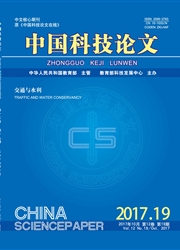

 中文摘要:
中文摘要:
针对季节冻土区冻融循环后路基强度分层的特点,将路基分为路基冻融层和路基未冻融层。以七自由度双轴重载汽车为例,基于D’Alembert原理,建立季节冻土区车辆-路面-路基体系耦合动力学数值模型,并以我国B级路面不平度为激励,采用Wilson-θ法对其动力系统方程进行求解。数值仿真结果表明,轮胎接地动力放大系数(DLC)前轴大于后轴,且路基冻融层刚度对其影响甚微;随着路基刚度由40MPa降至20MPa,路面振动平均位移峰值增加31%,路面振动平均加速度峰值增加5%。而且,所建立的车-路耦合模型为进一步研究季节冻土区车辆荷载作用下路基、路面动力响应奠定基础。
 英文摘要:
英文摘要:
According to the stratification characteristic of the subgrade stiffness induced by the seasonal freezing and thawing in seasonally frozen region, the subgrade was divided into the frozen-thawed subgrade and unfrozen-thawn subgrade. The coupled dynamic model of the vehicle-pavement-subgrade system was developed based on the D’Alembert principle, and a two-axle truck with seven freedom degree was taken as an example. Incited by the level B road displacement irregularity, the equation was solved using the Wilson-θ Method. Numerical simulation results show that, for Dynamic Load Coefficient (DLC) of tire contacting the pavement, the front axle is greater than the rear one, and the thawed subgrade stiffness plays a little role in DLC of tires. With the decreasing of the thawed subgrade stiffness from 40 to 20 MPa, the mean dynamic displacement peak increased by 31%, and the mean dynamic acceleration peak increased by 5%. Additionally, the developed interaction of vehicle-road system model provides the foundation for the dynamical response of pavement and subgrade induced by the vehicle in seasonally frozen region.
 同期刊论文项目
同期刊论文项目
 同项目期刊论文
同项目期刊论文
 期刊信息
期刊信息
